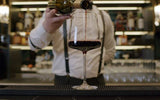
The Essential Bartender’s Guide To Becoming A Wine Expert


When you’re a bartender, your days and nights are bound to be filled with excitement. You get to mix and match a lot of ingredients to create the perfect drink and meet new people. But have you ever thought of giving your bartending career an upgrade? If so, have you ever considered becoming a wine expert?
There's something about wine that just makes it irresistible. Maybe it's the way that different flavors can complement each other so perfectly, or perhaps it's the sense of sophistication that comes with enjoying a good bottle of red.
If you're interested in learning more about wine, we've got you covered. In this blog post, we'll explore some tips for becoming a wine expert as a bartender.

If you have been a bartender for a while, but have little to no experience with wine, then try taking classes. You can sign up for such courses, where you will get to know all about wine. To top it off, you can also take a practice test at the end of your lessons to fortify your knowledge.
The WSET level 2 practice test is one of the most reliable ways to become a wine connoisseur. People who initially started in this field found the classroom experience beneficial. What’s even better? You can take the first two practice tests for free, so you do not have to worry about not having enough funds.

When you talk about wine, there are some words you need to keep in mind, primarily because they are used to identify the type, taste, smell, and feel of the wine.
Learning wine-related terminology will help you find the drink that your customer orders. Remember, they won’t mention their drink by their brand name but by the generic name of the wine they want.
Learning different wine terminologies such as aroma, bouquet, body, mouthfeel, acidity will help you describe the wine better to your customers, and you’d be able to help them with their wine selection.
Here are some meanings to some common wine terminologies:

To truly understand and appreciate wine, it is crucial to describe its taste. This can be a difficult task for beginners, but you'll be able to identify the different flavors in any glass of wine with a bit of learning and practice. So what exactly goes into making up the taste of wine?
You can describe the taste of wine based on its body, finish, sweetness, and notes—whether it is fruit-forward or earthy/savory.
Let’s use Pinot Noir as an example to simplify the use of wine language further to describe its taste. Pinot Noir is a red wine described as “light-bodied.” As we said earlier, “body” refers to the drink's strength. In this case, “light-bodied” simply means that the wine is subtle, and its alcohol content is low.
The taste notes for Pinot Noir are mostly cherry and strawberry with just enough spiciness to keep things interesting, and it has a long finish that's smooth as silk.
We describe the complex flavors mixed to produce the wine when we talk about taste notes. These words may look simple, but they hold a lot of information about the nature of the wine you’ll be serving.
Learning the correct wine-related terms is only half the job. You must know how and when to use those words, especially when describing the taste of the wine once it is consumed.

It would be hilarious if someone knew everything about a bottle of wine but didn’t know its name. Something like this is implausible because if someone claimed to be passionate about researching wine, they would go out of their way to learn which types of wine are most popular.
There are quite a few types of wines, all having complex compositions—but some are more well known than others. Champagne is undoubtedly everyone’s favorite. It’s a sparkling white wine that’s usually served on special occasions.
Others include Cabernet Sauvignon, Merlot, Chardonnay, Sauvignon Blanc, Rosé, Airén, Tempranillo, Syrah, and the one we earlier mentioned, Pinot Noir.
Keep a collection of these classics in your bar. They will, for sure, amaze your customers should they ever ask for it.

A bar isn’t always just a bar. Whenever people come in to have drinks, they are likely to stay awhile. Anyone who likes to go out for a drink knows that wine tastes even better when served with the right food.
Whether you’re a bartender, or a regular wine enthusiast, knowing how to pair wine with food correctly is critical. I might go as far as to say it is an art in itself. Some wines may overwhelm the taste of the snacks or food served, while others might add more flavor.
There are no rules for food-wine pairings; however, there is a theory that states certain wines complement the taste of particular foods.
Once you’ve learned how to pair food and drinks, you can accordingly prepare snacks at your bar. Rest assured that your customers will have a splendid time chatting and enjoying their drinks.
Whether you're looking to make a career change or want to take your bartending path to the next level, we hope this guide gave you some insights into the steps needed to become a wine expert.
Understanding all the terminologies and tasting many wines is required before describing what they taste like in words. But once you get your footing on understanding these things, you’ll be able to give your customers an experience they’ll want to relive!
As a beginner the guide really helped despite I’m yet to master the terms, types and names of wines


